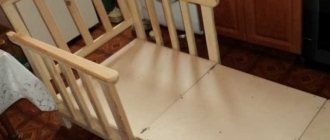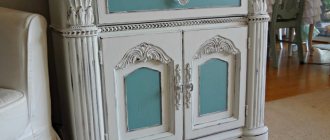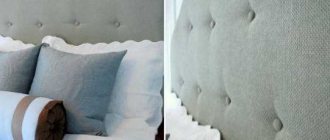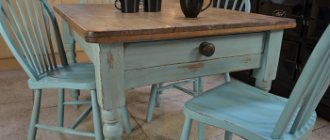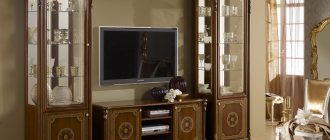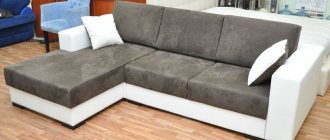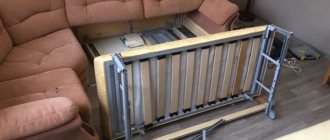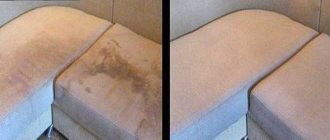Over time, scuffs or even holes appear on the sofa, which immediately pushes the owner to get rid of the old furniture and buy a new one, spending a significant amount of money. Don’t rush to throw away your old sofa, because with the help of a few meters of fabric and padding polyester you can turn it into a completely new piece of furniture. Restoring a sofa yourself is not as difficult as it seems. The process itself is very interesting and creative. In this article, we will consider the stages of restoring a sofa with your own hands.
What does restoration of a sofa involve?
The choice of method for restoring a sofa depends on the degree of wear and tear of the materials from which the sofa is made. If there are stains on the upholstery, you can simply treat the fabric with a cleaning agent. Nowadays, you can use detergent without even removing the upholstery from your sofa. Surfaces are treated using active foam, which is then removed with a dry cloth.
If you see slight deformations of the surfaces, it means the foam has worn out. If the upholstery wears out, you will have to use more serious restoration methods. It will be necessary to completely replace the old soft elements with new ones. Restoring and reupholstering a sofa with your own hands will completely change the appearance of your old sofa and transform it beyond recognition. The work of reupholstering the sofa will take several days and will require care and attention. If there is not enough experience in this area, then reupholstering a sofa of complex design or antiques should be entrusted to a professional. In the article you can see the photo of the sofa after restoration. After reupholstering and replacing the foam, it is difficult to recognize it.
Elimination of defects on the sofa body
Before you begin removing old upholstery and trim, you should inspect the exterior woodwork of the sofa. If any damage or defects occur on them, they must be eliminated. Moreover, when minor damage is caused, this can be done without even disassembling the furniture.
Sofa body diagram.
Minor damage can be repaired in the following ways:
- Very small scratches can be removed from the surface using a walnut. To do this, you need to take a nut and rub it on the scratched area, and then wait a little until it darkens to match the tone of the main wood. Afterwards you need to wipe the area a little with a napkin and cover it with clear varnish.
- A great method for getting rid of minor scratches is to use a furniture touch purchased from a hardware store. This product should be applied to the damaged surface, filling the scratches with it, and after 10 minutes, walk over it with a damp cloth.
- Wooden parts made of oak, mahogany or walnut can benefit from an iodine solution if you rub it on the damaged areas.
- You can treat the wood with stain. However, in this case, the product will not hide the scratches, but will simply paint the wood on top.
For more serious damage, such as chips and cracks, you will need to purchase wood putty that matches the tone of the furniture from a hardware store and carefully apply it in small amounts to the damaged area.
After the crack or chip is filled with putty, all that remains is to go over it with a spatula and level the surface.
Scheme of the side of the sofa.
When the wooden parts of the sofa are very damaged, it is impossible to do without removing them and disassembling the sofa. Elements that have become completely unusable (for example, those that have been chewed by animals) will have to be replaced by ordering new ones from a furniture company. If you need to redo the damaged coating of an entire part, the first step is to remove the layer of varnish and paint. When this is not possible, you will simply have to sand the surface. A special primer for wood is applied to the element, and paint or drying oil is applied to the part. If necessary, it is additionally coated with varnish. After the coating has dried, all that remains is to put it in place and begin further work on remaking the sofa with your own hands.
Related article: How to make a curtain from buttons yourself: homemade secrets
Remodeling is a creative process, so you can show your imagination and hide existing flaws in the wood using decorative elements, such as mosaics or other decorations.
Necessary equipment and materials
To restore a sofa with your own hands, you will need a minimal set of tools. Without them, the work cannot be completed:
- hammer;
- furniture stapler;
- Staples;
- nails, screws;
- roulette, level;
- marking pencil;
- scissors;
- pliers;
- screwdriver;
- glue;
- sandpaper;
- brushes;
- sewing machine;
- jigsaw
We list the materials that will be needed when reupholstering and restoring an old sofa:
- furniture fabric;
- foam rubber thickness 10 cm, 5 cm, 2 cm;
- padding polyester;
- varnish, acrylic paint or stain;
- boards of the required size;
- Fiberboard, plywood.
In some cases, a new sofa mechanism or new fittings may be needed. The mechanism is replaced if metal elements are deformed or damaged and cannot be replaced. Perhaps the mechanism simply needs to be lubricated.
Do-it-yourself restoration of an old sofa
If you plan to continue to use the structure for its intended purpose, then it is necessary to carry out repair work. They can be quite serious. Carpentry skills may be required if new parts need to be made. Or maybe everything can be done with “little blood” - just correcting the appearance.
What elements need to be replaced?
There is a misconception that in order to restore a sofa, it is enough to change its upholstery. But wear processes affect not only the external material. After a long and especially intensive service, the frame of the structure often becomes unusable.
Therefore, before repairing, pay attention to the following factors:
- External covering. Typically, leather or fabric material becomes dull and frays.
- Filler. As a rule, it loses its elasticity.
- Wooden frame. If it is loose, it must be secured. If there are cracks on the elements, they need to be replaced.
- Transformation mechanism. It may jam due to misalignment. Problems also arise with fittings or return springs.
You can replace not only the upholstery, but also other elements.
Note! If replacement is required, it is better to find parts from the original manufacturer.
Otherwise, there is a possibility that the element will have an incomplete fit and subsequently fail faster.
Required tools and materials
It is not necessary to use the same materials as in the old sofa. Perhaps they are already outdated, and stores sell more modern types of them. Filling and upholstery fabric are purchased only after removing old materials from the frame and taking exact measurements.
To work you need to prepare:
- screwdriver;
- screwdrivers;
- pliers;
- stapler;
- nylon thread;
- a needle with a large hole;
- tape measure and pencil;
- chalk for cutting;
- universal glue;
- sandpaper for wooden parts;
- lubricant for the transformation mechanism.
For work you will need a screwdriver and other tools.
Stages of work
Do-it-yourself restoration of sofas is carried out in stages. Each operation is performed without haste. And only after completely completing the previous one do they begin the next one. Let's look at how to restore a sofa that has fallen into disrepair with your own hands in more detail.
Preparation and disassembly of the product
During the process of dismantling the structure, the scale of restoration is assessed. First, the side panels with armrests are removed. To do this, the fastening bolts are unscrewed from the inside. Then the seats and backrest are dismantled. After this, the frame is inspected for defects.
Important! When dismantling, it is better to separate the fittings into different packages and be sure to sign each one. This makes subsequent assembly easier.
For restoration, the product must first be disassembled.
In order to remove the old upholstery, all staples must be removed. Usually, under the fabric there are several layers of thin felt or padding polyester. It is better to subsequently replace this material with new one. When the filler is removed, the possibility of its reuse is assessed.
But it should be remembered that this material usually lasts no more than five years. If replacement is required, it is necessary to measure the thickness, width and length of the plates.
Lastly, check the integrity of the springs. Usually the block serves well for several decades. But if there are burst elements or they creak, then they need to be replaced.
The springs may also need to be replaced.
Selection of materials
Do-it-yourself restoration of an old sofa always involves changing the upholstery material. Usually they choose inexpensive and practical furniture fabrics that are easy to care for.
Perfect for these purposes:
- jacquard;
- velours;
- chenille;
- flock;
- tapestry;
- eco leather;
- microfiber.
Different types of materials are suitable for upholstery.
But you can successfully use natural leather. The cost of restoration will simply increase significantly.
For filler use:
- foam;
- polyurethane foam;
- latex.
You need to choose a filling option for the sofa.
The latter is more preferable because it is durable and environmentally friendly. But the first two are cheaper.
Repair of elements
They are starting to restore the old sofa from the frame. It is there that replacement of wooden blocks is most often required. Then they move on to the fittings and spring block.
The sequence of operations is as follows:
- Damaged elements of the frame are renewed.
- Investigate the mechanism of transformation. If there are bent parts, they are not restored, but replaced with new ones.
- Remove rust from the spring mechanism (WD-40 helps) and apply fresh lubricant.
- The new filler must be placed on a felt base and glued.
- A layer of padding polyester or holofiber is laid.
- Upholstery fabric is cut to size, always leaving a sufficient margin (5-10 cm).
- Having secured one end on either side of the frame, the fabric is pulled (not too tightly) and fixed with a stapler on the other.
- Then the material is leveled and secured from the sides.
Note! Old covers may come in handy. Using them you can easily take measurements for cutting new material.
Assembly
The repair is completed by installing the structure:
- The base is assembled.
- Install the side parts. Make sure there are no creaks or backlashes.
- The backrest is secured.
- The seat is installed.
- Sidewalls are hung.
- If there is, then decorative elements are installed.
The assembly steps are similar to dismantling, but only in reverse order. To avoid confusion, it is recommended that when disassembling the structure, all processes are recorded on a camera.
Final stage
After the furniture has been assembled, the sofa is installed in its place. At this stage, the final decoration of the structure with various elements is carried out.
Accessories for sofas
Modern fittings will not only add functionality to your sofa, but also update its appearance. The most important mechanical element of the fittings for folding sofas is the transformation mechanism. When restoring a Soviet sofa with your own hands, it is recommended to change the transformation mechanism to a new one. If the old sofa has become difficult to unfold, then you can try to lubricate the moving elements of the mechanism with a special lubricant. If elements are broken or deformed, a new transformation mechanism will have to be installed.
The legs of the sofa can be equipped with furniture wheels if this piece of furniture is expected to be moved periodically. The wheels must be correctly selected according to the weight of the sofa. Otherwise they won't last long. Connecting elements should be replaced if necessary: corners, couplers, etc. Some sofas require drawers. You can change the guides: instead of roller ones, use ball ones, for example. Such a drawer will slide out smoothly and easily.
Dismantling the old coating and cutting the material
The next step that needs to be taken to remodel the sofa yourself is to dismantle the covering that has become unusable. To do this, you should disassemble the sofa, and it is important to remember which parts were located where. To make the task easier, you can use a video camera. When disassembling, you just need to remove each stage. Then assembling the furniture after the remodeling is completed will not be difficult. A camera is also perfect for this purpose.
First of all, the armrests are removed from the sofa, which in some cases can be combined with the legs. Next, the sides of the sofa, the transformation mechanism, the seat and the back are removed. The sofa is disassembled until only the frame remains.
After this, you need to remove the upholstery material, using, if necessary, a destapler and prying the fabric with a knife or scissors. When all the parts of the sofa are freed from the old material, you should also get rid of the filling. With prolonged use, it usually becomes unusable, especially if the sofa filler is foam rubber or padding polyester.
Sofa upholstery scheme.
First of all, those pieces of foam rubber that are easy to separate are removed from the frame. Small parts of the sheathing are scraped off the frame with a spatula, but this must be done carefully so as not to spoil the wood. You should not try to remove stuck pieces of foam rubber or padding polyester with your hands. It's better to do this with a tool. If you cannot remove the upholstery even with a spatula, you should soak the remaining pieces with warm water and repeat the process. Before proceeding with further alterations to the sofa, it is important to ensure that all upholstery parts have been completely removed. Use a wet sponge to remove small loose pieces from the frame, and then wait until the wood dries. Under no circumstances should you continue working until the frame is completely dry: this is fraught with fungus and rotting of both the wood and the upholstery.
The next thing you need to do to make a sofa with your own hands is to cut and prepare the upholstery fabric. It’s better to cut out all the elements at once. This can be done conveniently using a special chalk (if you don’t have fabric chalk, you can replace it with a piece of regular dry soap). The pattern is made from removed, old material or from the furniture parts themselves. Before further work, the cut fabric must be processed on a sewing machine: hem the edge of the fabric so that it does not unravel. The lining material is also measured and processed.
Related article: A small corridor in a Khrushchev building is not a death sentence
After the fabric is ready, the foam lining is cut out. It is cut to the size of the sofa, while allowances of 5 cm are also left at the lining. For alterations, you should use only good, very dense foam rubber, since material with a low density deforms extremely quickly, and, therefore, such upholstery will not last long . Then the lining should be tried on to the parts of the sofa and, having made sure that all the patterns match the details, you can safely move on to the main stage of the alteration - the actual upholstery of the sofa.
Preparing the sofa for reupholstery
First you need to remove all the fabric upholstery. Detach it carefully so that the patterns do not tear; they will be needed later. Restoring leatherette on a sofa with your own hands is complicated by the fact that heavily worn material can simply tear when separated from the frame. Assess the condition of the foam rubber. If visually it seems asymmetrical and deformed, and in some places even torn, then the filler will have to be changed. If the foam rubber is suitable for further use, and the padding polyester needs to be changed, then you may need to use a utility knife to separate it, since the padding polyester is connected to the foam rubber with glue.
In most cases, when creating a sofa, a thick layer of foam rubber is first installed, then a thinner one, and on top they are covered with several layers of padding polyester. In some cases, it is enough to just replace the padding polyester and leave the layers of foam rubber from the old upholstery.
Some frame elements may lose their strength and become deformed over time. This happens especially often with materials such as chipboard and fiberboard. After completely disassembling the sofa, you will have to replace them with new elements.
Repair of frame and transformation mechanism
The frame is the base of the sofa. Most often, the frame is made of wooden beams and boards. Replacing broken elements is not difficult, you just need to take measurements, cut out new parts and install them in place of the old ones. Elements that have cracks will also have to be replaced. You can see in the article in the photo the restoration of a sofa, the frame of which is made of timber and boards.
The transformation mechanism can be repaired in extremely rare cases. If it fails or metal elements break, you will have to buy a new mechanism of this type. Before purchasing, you need to take careful measurements or take the elements of the mechanism with you so as not to make a mistake when choosing the right model.
Economical interior update
Old furniture will be an excellent basis for updating the interior. You can create harmonious sets that will fit perfectly into the design of both a city apartment and a country house.
Interesting combinations can be achieved in a Soviet-style dacha setting. You can equip a cozy relaxation corner consisting of an old sofa and armchairs. It is enough to simply replace the upholstery with a more modern one.
To create a cozy relaxation area, just update the furniture upholstery
A kitchen with chairs or stools, the seats of which are decorated with pieces of old carpet, looks stylish. This design will allow you to create a unique atmosphere of coziness and comfort.
Old furniture can be used in the following interpretations:
- Use of furniture for its intended purpose.
- The basis for creating interesting options.
- A combination of several items to create a single and unique style.
The combination of several Soviet interior items creates a unique atmosphere
Your imagination will allow you to come up with stylish solutions that will decorate your living room, bedroom or child’s room. Various combinations are also possible when equipping a work office.
The main advantage of such a transformation is saving money, because you don’t have to buy new furniture. All items made many decades ago are of excellent quality and are ready to serve for many more years.
By transforming Soviet furniture you can save a lot of money
High-quality Soviet furniture in a modern interior looks elegant, allows you to show your imagination, create a cozy and unique atmosphere of harmony and comfort. You will be able to give joy to yourself and your elderly relatives, who will be very pleased with your wonderful ideas.
Choice of upholstery material
When choosing fabric, it is not enough just to decide on the color and pattern depicted on the canvas. It is very important to know the characteristics of the fabric that will be used to cover the sofa. Let's look at some furniture fabric options.
- Matting. Inexpensive and affordable option for furniture fabric. The fabric is quite durable and not prone to stretching. Most often there are single-color options, but there is a matting with spraying. The material is easily cleaned from contaminants due to the synthetic components in the structure.
- Velours. Quite expensive material. It has a high level of strength and resistance to dirt. The surface of the velor resembles velvet; the pile can be positioned vertically.
- Jacquard. This material is often used in the manufacture of furniture. Jacquard is a very durable and wear-resistant material that cannot be deformed. The fabric usually has a pattern that is embroidered with threads of different colors. If you have a cat in your house who likes to sharpen its claws on furniture, then this fabric will be the best option for upholstering a sofa.
- Chenille. Durable and wear-resistant material. You can choose a model that will be resistant to animal claws. The material is easy to clean and does not stretch. The cost is affordable for the average Russian citizen.
- Flock. The base fabric is made using cotton and polyester, after which pile is applied to the surface using an electrostatic method. The fabric is soft and rough to the touch. High strength and resistance to deformation are very important parameters when choosing a fabric; flock has both of these qualities. The material is easy to wash.
Fabrics for upholstering a sofa
The most commonly used fabrics for upholstering a sofa are:
An example of reupholstering old sofa upholstery with new one.
- Cotton fabric. The disadvantages of this material: it wrinkles easily and quickly frays. In addition, like all natural fabrics, it will cost more. The advantages of cotton fabric are a very wide range of colors.
- Velor in its appearance resembles velvet. It is very beautiful, and a sofa upholstered in this material looks luxurious. Another plus of velor: it is easy to clean. However, the wear resistance of this fabric is not up to par; it wears out quickly.
- Jacquard fabric is characterized by high density and long service life. It has a relief structure, a bit like a tapestry, and, as a rule, has beautiful designs. The downside of this fabric is its relatively high price.
- Flock is a material with pile that is created using a non-woven method. It looks interesting, but is easily electrified and because of this it quickly collects dust. The positive aspects of flock are its durability, high breathability and waterproofness.
- Arpatek is a very popular type of material for upholstery. Outwardly it looks like leather. Arpatek is practical and reliable, and its cost is cheaper than that of genuine leather. A sofa covered with arpatek looks very aesthetically pleasing.
- Chenille is also a very popular material in furniture production. This is a natural fabric with a slight addition of synthetic fibers. Chenille looks great and comes in a variety of colors. It is durable, does not absorb unpleasant odors, is easy to clean and does not cause allergies. Cons of this fabric: It can only be dry washed and it snags easily. If there are cats in the house, it is better not to cover the sofa with chenille.
- Tapestry. Modern tapestry fabric is a mixture of cotton and polyester in equal parts. The tapestry is practical, wear-resistant, and easy to care for. It comes in a variety of beautiful patterns and looks great, especially on old, elegant sofas or in vintage-style interiors.
Related article: What to plant in the fall at the dacha: 7 tips for gardeners (38 photos)
Cutting upholstery fabric
The fabric for the new upholstery is cut using old patterns. To do this, you need to straighten the patterns, attach them to a piece of fabric and secure with pins. Next, we trace the pattern along the contour and cut it out, making indents along the edges. When cutting, be sure to pay attention to the direction of the longitudinal thread.
If the old upholstery fabric is severely deformed or stretched, then you will have to measure some parts of the sofa with a flexible ruler. To ensure strong seams, choose a more reliable type of connection and zigzag the free edges of the fabric.
Filler selection
To create a soft surface of the sofa, you will need foam rubber 10 cm wide. The back cushions are made from this material, if they are separated from the main structure, the base of the seat. Foam rubber 5 cm wide is used for the sides. The armrests are covered with it. For the remaining parts of the frame, foam rubber 2-3 cm wide is suitable. The back of the sofa does not need to be covered with foam rubber.
Foam rubber can be of different densities. It is this parameter that determines its softness. For a sofa, it is better to take the densest foam rubber. Pay attention to the durability factor. The higher this indicator, the longer such foam rubber will last and the more expensive it will cost.
Installing a new filler
The foam rubber is attached to the frame parts using a furniture stapler. In some cases, glue is used. If the design of the sofa assumes the presence of smooth rounded transitions, then the foam rubber will be laid out in the directions of these bends, and the fastening will be carried out at the most extreme point of the rounding. The stapler staple should be in an inconspicuous place from the edge of the foam sheet.
The padding polyester is stretched over the foam rubber so that the upholstery fabric does not wear off the foam rubber coating. When restoring a sofa with your own hands, you can take several layers of padding polyester. They are fixed using glue in cans. The composition is sprayed onto the surface of the foam rubber, after which a padding polyester is applied, stretched and secured with the staples of a furniture stapler on the frame. Sintepon is a very soft and airy material. If you want the surface of the sofa to have increased softness, then increase the number of layers of padding polyester.
Advantages and disadvantages of restoration
All the advantages boil down to the following:
- The family budget is significantly saved. This is the main advantage, since repairs are always cheaper than buying a new thing.
- Preservation of antiques. Antique items have good prices. But if they have visible defects, then the price drops significantly. Therefore, it is better to update them before selling them.
- It's easy to choose the right color scheme. It is always easier to buy fabric in the right color than to buy a ready-made item.
- Replacing the material with a higher quality one. If you are not short on money, you can turn an old sofa into an exclusive item.
- Knowing the weak points of the structure, you can eliminate these problems by reliably strengthening the parts.
Restoring a sofa with your own hands has many advantages.
We can say that there are no cons at all. Well, except for one thing. Instead of a new sofa, you will have to use the old one.
Restoring a sofa that has lost its attractive appearance is not only economically beneficial. At the same time, various opportunities open up, both to use a thing dear to the heart further for its intended purpose, and to find a new use for it.
Treatment of wooden surfaces of a sofa
Over time, the wooden elements of the sofa wear out and begin to look unaesthetic. To correct this, it will be necessary to carry out a number of measures to restore them. First you need to disconnect all the wooden inserts from the frame. The photo of the do-it-yourself restoration of the sofa shows that the wooden elements form part of the frame, so they will have to be processed without separating them from the frame.
To clean old layers of paint or varnish, you can use sandpaper or a sander. It all depends on the complexity of the surface being treated. The old paintwork material must be completely removed.
When restoring an old sofa with your own hands, you may observe deep scratches on the wooden decorative elements. To remove them, you will have to use putty. It must be of suitable composition. After treating the surface with putty, you need to wait for it to dry completely and sand the surface again, achieving a perfectly smooth texture. Wooden elements that have been treated with putty can no longer be coated with varnish alone, since the transparent layer will reveal uneven color of the surface. You will have to use acrylic wear-resistant paint.
Remodeling methods
A variety of techniques allow you to update furniture with your own hands, but the basic algorithm of actions remains unchanged. In any case, the structures are carefully inspected, strengthened and cleaned of dirt. The preliminary stage is completed by preparing the workplace, tools and materials.
Tips for painting furniture yourself, choosing a composition, stages of work
Painting
This method is considered universal, since the “correct” paints help to remake any cabinet furniture, including a Soviet wall or outdoor (garden) sets. There is only one general condition: the surfaces to be painted must be as smooth, clean and dry as possible. To simplify the work, the painting process is divided into several stages:
- Disassembling furniture into individual parts, removing fasteners, fittings, and sliding parts.
- Protect fragile, non-paintable surfaces with film using tape.
- Removing dirt, old coatings, grease stains.
- Cleaning surfaces with abrasive materials.
- Covering cracks or chips (if any) with wax or wood putty.
- Priming, dust removal, drying of parts.
- Consistent painting of hard-to-reach areas and all other furniture surfaces.
- Varnishing (if necessary).
- Removing the film, reassembling.
To renew furniture coatings, it is recommended to use environmentally friendly paints and varnishes with a corresponding mark on the label. Acrylic, chalk or thixotropic paints that form a minimum of drips are best suited for these purposes. The terms and conditions for their drying are specified in advance.
Furniture disassembly
Removing dirt, old coatings, grease stains
Surface cleaning
Closing cracks or chips
Priming, dust removal, drying of parts
Coloring
Varnishing
Reassembly
Pasting with film
This remodeling technique is valued for its high speed of work, the ability to simultaneously improve the moisture resistance and decorative properties of furniture coverings, its low cost and the absence of dirty processes. Suitable for all types of furniture, except upholstered ones. The step-by-step instructions largely coincide with painting: the product must be washed, degreased, and dried. Film blanks are cut out in advance, after careful measurements of the structures.
Installation is carried out from a corner or edge, with gradual removal of the protective film (in the absence of experience - 5 cm). To level the coating, use a wallpaper spatula, cut off the excess with a stationery knife, and correct any defects immediately. After gluing the ends with a hair dryer or iron, the furniture can be put into operation immediately.
Tips for repairing furniture depending on the type of damage
Artificial aging
This technique allows you to radically change the style of furniture at home and at relatively low cost. Work begins as standard with surface cleaning, degreasing and drying. The further procedure depends on the specifics of the chosen method.
| Name of equipment | The essence of the method, the materials used |
| Dry brush | Apply a little contrasting paint to a flat brush with synthetic bristles, and wipe off the excess with paper. The surface is painted with an almost dry brush, without pressure or rubbing of paint. |
| Patination | A paint composition (bitumen or shellac varnishes, highly diluted acrylic paints, oxidizing agents, colored waxes, stain) is applied or poured onto furniture coverings; the excess is wiped off with a clean, lint-free cloth. |
| Glaze | Surfaces are painted with translucent compounds; individual layers can be multi-colored |
| Artistic spray | A hard, wide brush is moistened with water, lightly picks up paint and shakes over the product. If desired, the process is repeated with brushes of different formats (up to a toothbrush). After drying, the surface is opened with transparent varnish |
| Craquelure | One- or two-layer coating of furniture with self-cracking varnishes |
| Creating decorative abrasions | Corners, joints and similar problematic abraded areas are successively covered with bright, saturated paint, paraffin, and the entire surface is covered with 2 layers of light paint. After drying, the top layer is removed with sandpaper along with paraffin. |
| Etching | The technique is used when working with natural wood to emphasize its texture. There are 2 options: applying etching compounds with swabs or soaking parts in a container with a solution |
| Brushing | Old furniture is cleaned with metal brushes or hot sand. The treated surface is glazed, varnished or painted with a dry brush. |
Artificial aging is perfect for furniture made of natural wood, chipboard, MDF.
The above list is far from complete; if desired, methods of artificially aging the surface can be combined to obtain unique patterns and coatings. The technique is considered simple, but to understand the essence of the processes, it is worth studying a master class on remaking furniture or checking the procedure with paint and varnish sellers. To save money, test strokes are made on other surfaces.
Dry brush
Patination
Glaze
Artistic spray
Craquelure
Creating decorative abrasions
Etching
Brushing
Upholstery of upholstered furniture
The essence of this method is to update the textile coverings (and in some cases, the internal filling) of upholstered furniture for any purpose. The technology is considered costly, complex, but pays off. With proper selection and installation, new upholstery will last for decades. The standard algorithm includes the following steps:
- Assessment of the condition of upholstered furniture, selection and calculation of materials.
- Dismantling, strengthening structures, removing old upholstery. At this stage, the internal wooden elements should be well soaked with antiseptics.
- Textile cutting, fitting, preliminary and final fixation with staples with fine steps. Properly fastened fabric will not form wrinkles, distortion of the pattern or sagging.
- Reassembly.
Stages of superficial and complete restoration of old furniture with your own hands
If it is necessary to update foam rubber, springs or supports of upholstered furniture, the scheme becomes more complicated. In such cases, a layer of new foam rubber is attached to the frame first, and only then the fabric. There are no problems with choosing the latter; the range of modern furniture textiles is represented by materials for every taste and budget.
Selection and calculation of materials
Dismantling, strengthening structures, removing old upholstery
Textile cutting, fitting
Fixing tissue with staples
Reassembly
Decorating the sofa
Usually sofas are decorated if the furniture is made in a classic style. When restoring an old sofa with your own hands, you can add some zest to its appearance. The presence of ruffles and hanging tassels are signs of the classic trend. The material for such a sofa needs to be chosen expensive and elegant. You can sew a cover.
Wooden elements are treated with varnish or stain. Stain gives the wood texture a noble shade. In the 17th-19th centuries, it was fashionable to do decoupage on solid furniture elements. It looked incredibly elegant. To perform this technique, you need to prepare a paper drawing cut out along the contour. This pattern is glued to the surface of the furniture using PVA glue. When the surface is completely dry, the decorated piece of furniture is coated with several layers of varnish.
You can make small pillows for decoration. In the case of a classic sofa, the pillows can be trimmed with fringe around the edges or decorated with ornaments. The fabric of the pillows should be identical to the fabric of the upholstery. For modern sofas, you can also use pillows for decoration. Moreover, it is not necessary to use the same color, but the fabric should be the same as the upholstery fabric.
The decor is unacceptable for furniture made in the style of minimalism or hi-tech. The sofa should be strict and monochromatic; its shape can only be linear.
